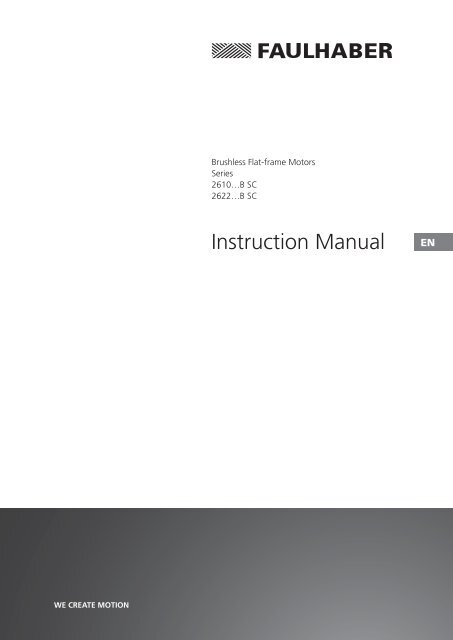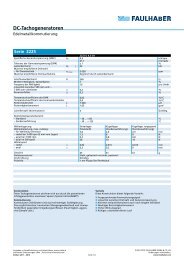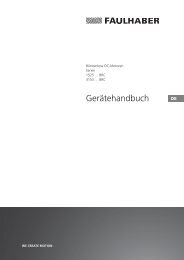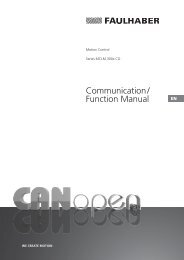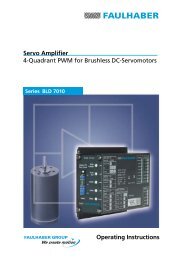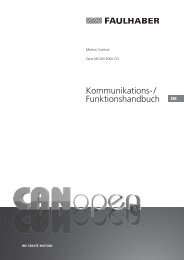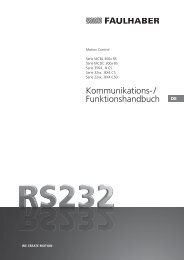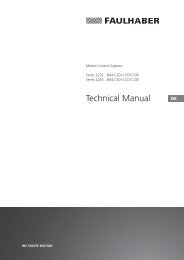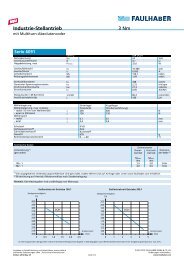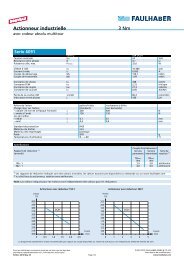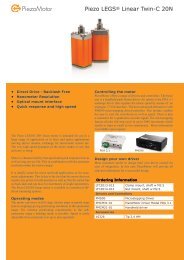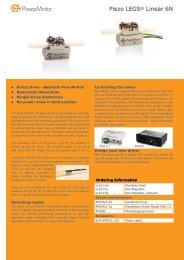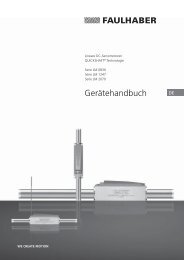Instruction Manual - Dr. Fritz Faulhaber GmbH & Co. KG
Instruction Manual - Dr. Fritz Faulhaber GmbH & Co. KG
Instruction Manual - Dr. Fritz Faulhaber GmbH & Co. KG
Create successful ePaper yourself
Turn your PDF publications into a flip-book with our unique Google optimized e-Paper software.
Brushless Flat-frame Motors<br />
Series<br />
2610…B SC<br />
2622…B SC<br />
<strong>Instruction</strong> <strong>Manual</strong><br />
EN<br />
WE CREATE MOTION
Imprint<br />
Version:<br />
2nd issue. 18.03.2013<br />
<strong>Co</strong>pyright<br />
by <strong>Dr</strong>. <strong>Fritz</strong> <strong>Faulhaber</strong> <strong>GmbH</strong> & <strong>Co</strong>. <strong>KG</strong><br />
Daimlerstr. 23 / 25 · 71101 Schönaich<br />
All rights reserved, including those to the translation.<br />
No part of this description may be duplicated, reproduced,<br />
stored in an information system or processed or<br />
transferred in any other form without prior express written<br />
permission of <strong>Dr</strong>. <strong>Fritz</strong> <strong>Faulhaber</strong> <strong>GmbH</strong> & <strong>Co</strong>. <strong>KG</strong>.<br />
This technical manual has been prepared with care.<br />
<strong>Dr</strong>. <strong>Fritz</strong> <strong>Faulhaber</strong> <strong>GmbH</strong> & <strong>Co</strong>. <strong>KG</strong> cannot accept any<br />
liability for any errors in this technical manual or for the<br />
consequences of such errors. Equally, no liability can be<br />
accepted for direct or consequential damages resulting<br />
from improper use of the equipment.<br />
The relevant regulations regarding safety engineering<br />
and interference suppression as well as the requirements<br />
specified in this technical manual are to be noted and followed<br />
when using the software.<br />
Subject to change without notice.<br />
The respective current version of this technical manual is<br />
available on FAULHABER's internet site:<br />
www.faulhaber.com<br />
2
Table of <strong>Co</strong>ntents<br />
1 Important Information 4<br />
1.1 Symbols used in this instruction manual 4<br />
1.2 Safety instructions 5<br />
1.3 Ambient conditions 6<br />
1.4 Service / Maintenance 7<br />
1.5 Troubleshooting 7<br />
2 Description 8<br />
2.1 General product description 8<br />
3 Installation 9<br />
3.1 Assembly 9<br />
3.2 EMC compatible installation 10<br />
3.2.1 Description of the EMC measures 10<br />
3.3 <strong>Co</strong>nnector pin assignment 11<br />
3.4 <strong>Co</strong>nnection diagram 12<br />
4 Functional Description 13<br />
4.1 <strong>Co</strong>nnection functions 13<br />
4.2 <strong>Co</strong>nfiguration 15<br />
4.3 Special configurations 16<br />
4.4 Parameter settings 18<br />
4.5 Technical information 20<br />
5 Operation 22<br />
5.1 Powering on 22<br />
6 EC Product Safety Directives 23<br />
7 Warranty 24<br />
3
1 Important Information<br />
This instruction manual describes the handling and operation of the following FAULHABER brushless<br />
flat-frame (pancake) motors:<br />
2610…B SC<br />
2622…B SC<br />
• Please read through the complete instruction manual before using the software.<br />
• Keep this instruction manual in a safe place for later use.<br />
The information given in this instruction manual refers to the standard version of the motors.<br />
Please refer to any additional information sheet provided in the event of differences in information<br />
due to a customer-specific motor modification.<br />
1.1 Symbols used in this instruction manual<br />
WARNING!<br />
Warning!<br />
This pictogram with the wording "Warning!" indicates an imminent danger which can result in<br />
physical injuries.<br />
ffThis arrow points out the appropriate action to take to prevent the imminent danger.<br />
CAUTION!<br />
Caution!<br />
This pictogram with the wording "Caution!" indicates an imminent danger which can result in slight<br />
physical injuries or material damage.<br />
ffThis arrow points out the appropriate precautions.<br />
REGULATION!<br />
Regulations, guidelines and directives<br />
This pictogram with the wording "Regulation" indicates a statutory regulation, guideline or directive<br />
which must be observed in the respective context of the text.<br />
NOTE<br />
Note<br />
This "Note" pictogram provides tips and recommendations for use and handling of the component.<br />
4
1 Important Information<br />
1.2 Safety instructions<br />
Observance of the following safety instructions is prerequisite for trouble-free and safe operation of<br />
the products. Therefore, please carefully read through all the notes and follow them when using the<br />
motors.<br />
Intended use<br />
The servomotor is designed as a drive for small mechanical systems, and for applications with speed<br />
control in a minimum space.<br />
• The motor contains magnetic and electromagnetic components. Any effects as well as the specific<br />
relevant national regulations must be taken into account when using the motor.<br />
• The motor may not be used in environments where contact with water, chemicals and / or dust is<br />
possible or in potentially explosive atmospheres!<br />
• The forces, torques and accelerations acting on the motor are limited.<br />
• Please ask the manufacturer for information about individual use under special ambient conditions.<br />
5
1 Important Information<br />
1.3 Ambient conditions<br />
CAUTION!<br />
Shock loads<br />
The noise emitted is increased and the life of the ball bearings and therefore of the motor becomes<br />
limited if they are exposed to impacts.<br />
ffThe motor can still function if it is not exposed to higher shock loads than defined according to<br />
EN 60068-2-27.<br />
ffThe motor may not be exposed to higher vibratory stresses than defined according to<br />
EN 60068‐2‐6.<br />
CAUTION!<br />
Risk of damage<br />
If the motor is installed on the mounting flange, the mounting flange can be damaged by<br />
high radial loads or stresses on the motor or by screws tightened with excessive torque.<br />
ffTighten the screws with maximum 40 Ncm. Note the strength of the screws!<br />
NOTE<br />
Service life<br />
The full life is reached if the motor is not exposed to shock or vibration loads.<br />
CAUTION!<br />
Risk of damage<br />
The ribbon cables may be damaged if the static or dynamic load is too high.<br />
ffThe tension exerted on the cable may not exceed 20 N in each direction. If the cable is exposed to<br />
constant tensile loads the limit is 11 N.<br />
ffIn case of frequent bending, the recommended minimum bending radius is 10 mm. The possible<br />
number of bending cycles increases with increasing bending radius.<br />
ffIf the radii are small the cable may not be bent several times as otherwise the Litz wires will break.<br />
The bending radii if laid once must be larger than 1.2 mm.<br />
ffThe cable may not be bent at temperatures < -10 °C.<br />
6
1 Important Information<br />
1.4 Service / Maintenance<br />
The flat brushless DC motors are designed to be maintenance-free. No maintenance measures are<br />
necessary.<br />
1.5 Troubleshooting<br />
If operated as indicated in this manual, the flat brushless DC motors will function trouble free.<br />
Should a malfunction occur in spite of this please contact the manufacturer.<br />
Switchboard: +49(0)7031/638-0<br />
E-Mail: info@faulhaber.de<br />
Internet: www.faulhaber.com<br />
7
2 Description<br />
2.1 General product description<br />
Product information<br />
With this instruction manual, you receive instructions on installation and use of the Series 26…B SC<br />
drives, and the drives’ technical data.<br />
26 … T … B SC<br />
SC:<br />
Integrated Speed <strong>Co</strong>ntroller<br />
B: Brushless motor<br />
…<br />
Supply voltage of the motor<br />
T: Shaft diameter 1.5 mm<br />
10:<br />
22:<br />
Motor length 10 mm<br />
Motor length 22 mm<br />
26: Motor diameter 26 mm<br />
The flat brushless DC motor described in this manual comes equipped with integrated commutation<br />
electronics (speed controller) which provides many motor control possibilities.<br />
The motor offers the following functions:<br />
• <strong>Co</strong>ntrol of the speed through command value input or control of the speed through the motor<br />
voltage.<br />
• The direction of rotation is reversable with the use of the given control signal input.<br />
• The speed signal can be monitored at the frequency output.<br />
1<br />
2<br />
3<br />
4<br />
5<br />
6<br />
1 <strong>Co</strong>ver<br />
2 Ball bearing<br />
3 Electronic printed circuit board<br />
4 Steel yoke Part 1<br />
5 <strong>Co</strong>il form<br />
6 Steel yoke Part 2 and rotor magnet<br />
7 Ball bearing<br />
8 Motor housing<br />
7<br />
8<br />
CAUTION!<br />
Risk of damage<br />
The control input for direction of rotation is not intended for dynamic (4 quadrant) control. Reversing<br />
direction quickly over an extended period of time will damage the controller.<br />
ffDo not reverse the motor dynamically.<br />
8
3 Installation<br />
3.1 Assembly<br />
The flat brushless DC servomotor must be installed according to certain specifications to prevent malfunctions<br />
and damage.<br />
CAUTION!<br />
Material damage!<br />
Incorrect installation or installation using the wrong fixing materials can disrupt the motor's function<br />
and / or damage the motor.<br />
ffObserve the following assembly instructions.<br />
Ambient conditions<br />
Depending on the method of use the flat brushless DC servomotor can become hot. Appropriate<br />
cooling must be provided.<br />
Shaft loads<br />
When pressing parts on the motor shaft it must be held against on the opposite side. Otherwise the<br />
maximum allowable load values (axial at a standstill) must be noted and observed.<br />
Mounting flange<br />
The drive may only be fixed using the screw bushings on the front flange. We recommend locking<br />
the screws. Due to the square front flange the drive is not suited for assembly in a cylinder.<br />
Do not exceed the maximum allowable screw-in depth as given in the product data sheet.<br />
Electrical connection<br />
It is necessary to ensure that the ribbon cable is laid without risk of damage during installation and<br />
operation, e.g. through chafing, squeezing or bending. The maximum load of the cable must be<br />
noted and observed. See section 1.3 “Ambient conditions”.<br />
Specialised staff<br />
These products are intended for use by trained professionals or experts in the use of small motors<br />
who are familiar with the relevant regulations and directives: EMC Directive, Low Voltage Directive,<br />
Machinery Directive, VDE Regulations or accident prevention regulations. This user’s manual should<br />
be carefully read before powering on the drive.<br />
9
3 Installation<br />
3.2 EMC compatible installation<br />
CAUTION!<br />
Length of the connection leads<br />
The maximum length of the connection leads is limited.<br />
ffAll connection leads may not exceed a length of 3 m.<br />
Optimisation of performance with respect to emission and immunity requires the additional EMC<br />
measures:<br />
• Ensuring the necessary immunity in industrial uses can require use of an EMC suppressor circuit.<br />
Motor designation Use environment Interference type Action<br />
Motor with SC speed controller Industrial environment Immunity EMC suppressor circuit<br />
This table shows which additional EMC measures can be implemented to optimise the behaviour of<br />
the equipment in the intended environment with regard to immunity.<br />
The units are intended for industrial use only. If the devices are used in the home, in business or in<br />
commerce or in a small business, appropriate measures must be taken to ensure that the emitted<br />
interference is below the permitted limits!<br />
3.2.1 Description of the EMC measures<br />
The EMC suppressor circuit<br />
Circuit diagram 1<br />
Up<br />
C1 Ceramic capacitor 220 nF<br />
C2 Ceramic capacitor 220 nF<br />
Umot<br />
C2<br />
C1<br />
GND<br />
Unsoll<br />
DIR<br />
FG<br />
NOTE Capacitor C1:<br />
If the ceramic capacitor C1 is used, malfunctions can occur in PWMntarget operating mode.<br />
ffUse signal source with low internal resistance in PWMntarget operating mode.<br />
NOTE Capacitor C2:<br />
If using the ceramic capacitor C2, a firmware update with the Motion Manager PC firmware may no<br />
longer be possible.<br />
ffRemove the C2 capacitor when updating the firmware.<br />
10
3 Installation<br />
3.2 EMC compatible installation<br />
Circuit diagram 2<br />
D2<br />
D1<br />
0 – 10 V DC<br />
Up<br />
Umot<br />
GND<br />
Unsoll<br />
DIR<br />
FG<br />
Separate suppressor diodes (D1, D2) for UP and Umot if they<br />
have separate supply voltages.<br />
If only one supply voltage is used, (bridge between UP and<br />
Umot), one suppressor diode (D1) is sufficient. D1 and D2 e.g.<br />
P6KE33A from STMicroelectronics<br />
NOTE<br />
Exceptions:<br />
It may not be necessary to implement the additional EMC measures named. If the motor is fed e.g.<br />
from a CE-conforming power supply unit, the EMC suppressor circuit can be dispensable. In this case<br />
the power supply unit takes on the function of the EMC suppressor circuit according to circuit<br />
diagram 2.<br />
3.3 <strong>Co</strong>nnector pin assignment<br />
The 26…B SC motor is equipped with a six position connection cable (AWG 28).<br />
CAUTION!<br />
Electronic damage / ESD protection<br />
Electrostatic discharges at the connection pin assignment of the ribbon cable can result in irreparable<br />
damage to the motor.<br />
ffIt may only be processed in ESD protected workplaces.<br />
Incorrect connection of the cores can cause damage to or destruction of the electronics.<br />
ff<strong>Co</strong>nnect the connections in accordance with the connector pin assignment, see table.<br />
<strong>Co</strong>nnection pin assignment of the ribbon cable<br />
1<br />
2<br />
3<br />
4<br />
5<br />
6<br />
<strong>Co</strong>re<br />
Function<br />
1 (red) UP<br />
2 Umot<br />
3 GND<br />
4 Unsoll<br />
5 DIR<br />
6 FG<br />
11
3 Installation<br />
3.4 <strong>Co</strong>nnection diagram<br />
Flat brushless DC motor with integrated SC speed controller<br />
Two examples are given and are intended to clearly explain the operating modes of the brushless<br />
flat-frame motor with SC Speed controller. The figures given refer to a motor with a nominal voltage<br />
of 12 V.<br />
Electronic speed control<br />
Up<br />
12 V<br />
DC<br />
+<br />
–<br />
+ 3 V DC<br />
Umot<br />
GND<br />
Unsoll<br />
DIR<br />
ca. 300 Hz<br />
FG<br />
The motor rotates counter-clockwise with approx. 3000 rpm. The speed is electronically controlled.<br />
External speed control<br />
12 V<br />
DC<br />
+<br />
–<br />
0 V DC – 2 x UN<br />
(max. 18 V DC)<br />
+ 10 V DC<br />
Up<br />
Umot<br />
GND<br />
Unsoll<br />
DIR<br />
ca. 190 Hz<br />
FG<br />
The motor rotates, e.g. with approx. 1900 rpm in a clockwise direction. The speed is controlled via<br />
the motor voltage (Umot). Approx. 190 Hz (6 pulses per revolution) is measured at the frequency<br />
output (FG).<br />
190 pulses / sec. = 31.6 U / sec.<br />
31.6 U / sec. = 1900 rpm<br />
12
4 Functional Description<br />
4.1 <strong>Co</strong>nnection functions<br />
The flat brushless DC motor with integrated SC speed controller supports the following functions<br />
and/or operating modes:<br />
• <strong>Co</strong>ntrol of the speed through the voltage at the command value input.<br />
• <strong>Co</strong>ntrol of the speed through the coil voltage.<br />
• <strong>Co</strong>ntrol of the direction of rotation at the switch input.<br />
• Reading out the speed signal at the frequency output.<br />
UP (core 1, red)<br />
Supply voltage for the electronics.<br />
For voltage range: 4 … 18 V.<br />
Umot (core 2)<br />
Supply voltage for the motor winding.<br />
For voltage range: 1.7 … 18 V.<br />
GND (core 3)<br />
<strong>Co</strong>mmon ground.<br />
Unsoll (core 4)<br />
<strong>Co</strong>ntrol voltage for the target velocity.<br />
Voltage range: 0 … 10 V DC (no speed setpoint is defined for > 10 V DC … max. UP).<br />
The defined control range for Unsoll lies between 0 - 10 V DC. If the motor’s nominal voltage is applied,<br />
the maximum speed can be reached before the control limit of 10 V. In this case, the actual<br />
speed is limited by the motor properties. Full modulation occurs.<br />
If, at Unsoll = 10 V, the motor voltage is increased to such an extent that a higher speed than the set<br />
target velocity results, the Speed <strong>Co</strong>ntroller limits the speed to the set value. In these cases the maximum<br />
speed value can be adjusted, as described in section 4.3 “Special configurations”.<br />
The input impedance of this cable is approx. 8.9 k.<br />
DIR (core 5)<br />
Switch input for the motor’s direction of rotation.<br />
To earth or U < 0.5 V anti-clockwise, U > 3.0 V = clockwise. Maximum allowable level = UPmax.<br />
FG (core 6)<br />
Digital output<br />
The digital output is a switch which switches to GND (open collector with integrated pull-up resistance<br />
of 22 k).<br />
Output voltage: max. UP.<br />
Current carrying capacity: max. 15 mA.<br />
The digital output can be configured for different tasks.<br />
13
4 Functional Description<br />
4.1 <strong>Co</strong>nnection functions<br />
Error output<br />
• Output switches to high level if current limiting is activated. The delay between activation of current<br />
limiting and activation of the output can be adjusted.<br />
• Output switches to low level if current limiting is deactivated<br />
Frequency output (condition on delivery)<br />
Frequency output for reading out the actual motor speed.<br />
Signal setup: 6 pulses per motor revolution.<br />
1 revolution<br />
NOTE<br />
Pull-up resistance<br />
An additional, external pull-up resistance can be connected to increase the edge steepness. The<br />
maximum loadability of the digital output must be noted and observed. See circuit diagram:<br />
1<br />
UP<br />
22 kΩ<br />
6<br />
Ω<br />
FG<br />
3<br />
GND<br />
Due to the coupling of the internal pull-up resistance between FG and the supply voltage UP,<br />
conducted electromagnetic RF interference, which affect the supply voltage, can drastically worsen<br />
the frequency signal.<br />
If operated properly and as intended, the speed and direct of rotation of the motor are not impaired<br />
by this interference.<br />
PWM mode<br />
If Unsoll is specified as the voltage at the motor it is operated with speed control. The speed is controlled<br />
by pulse width modulation (PWM), i.e. the motor tries to achieve a constant speed under<br />
fluctuating load.<br />
Due to the technical requirements for a motor with SC speed controller, if the allowable maximum<br />
housing temperature is adhered to, the maximum possible continuous torque in PWM mode may be<br />
lower than under full modulation. The maximum thermally allowable continuous current reduces<br />
accordingly.<br />
14
4 Functional Description<br />
4.2 <strong>Co</strong>nfiguration<br />
The control parameters of the SC speed controller integrated in the motor can be individually<br />
adjusted to the respective application via a PC. This requires a programming adapter which can be<br />
ordered separately as well as a version of the FAULHABER Motion Manager PC software suitable for<br />
the speed controller.<br />
The software is available on request or from the FAULHABER homepage<br />
www.faulhaber.com/MotionManager.<br />
CAUTION!<br />
Risk of damage<br />
Before starting up, the parameters configured in the control must be checked and if necessary adjusted.<br />
Incorrectly set values can cause irreparable damage to the motor and / or the speed controller.<br />
In particular, the following parameters must be correctly set:<br />
ffDuration and maximum current value,<br />
ffGenerator voltage constant kE and connected resistance R,<br />
ff<strong>Co</strong>ntroller parameter.<br />
The flat brushless DC motor is equipped with digital Hall sensors, with which the commutation<br />
signals can be determined. The actual speed value is determined via the time interval between the<br />
edges of the hall sensor signals.<br />
Preset default basic parameters:<br />
• Due to the resolution of the digital hall sensors, speeds from approx. 400 rpm can be stably controlled.<br />
• PWM frequency at the power output stage approx. 96 kHz.<br />
• 2-quadrant operation with function for quick speed reduction.<br />
The motor windings are short-circuited for faster transition from higher to lower speeds.<br />
Digital output<br />
Electronics supply<br />
Motor supply<br />
FG<br />
22 kΩ<br />
Up<br />
Umot<br />
Protection function:<br />
Overtemperature<br />
Setpoint input<br />
0 – 10 V DC<br />
Unsoll<br />
nsoll<br />
PI velocity<br />
controller<br />
3 Phase<br />
PWM<br />
Ua block<br />
commutator<br />
MOSFET<br />
Power<br />
output<br />
stage<br />
Phase A<br />
Phase B<br />
Phase C<br />
BL-Motor<br />
Rotational direction input<br />
DIR<br />
Evaluation<br />
rotational<br />
direction<br />
Speed<br />
calculation<br />
(t)<br />
Armature<br />
position<br />
calculation<br />
Hall sensor A<br />
Hall sensor B<br />
Hall sensor C<br />
I²t current<br />
limitation<br />
Iist Motor<br />
model<br />
5 V-<strong>Co</strong>ntrol<br />
VCC<br />
+5 V<br />
Microcontroller<br />
RM<br />
kE<br />
GND<br />
Signal GND<br />
15
4 Functional Description<br />
4.2 <strong>Co</strong>nfiguration<br />
Setting options<br />
• Pure 2-quadrant operation without active braking option.<br />
If problems occur with the braking function in the default setting it can be deactivated.<br />
• Filtering (averaging) of the hall sensor signals.<br />
If problems occur with the default setting the time of a complete electrical (half) motor revolution<br />
is evaluated to obtain a continuous speed signal. This can cause instable motor running at<br />
low speeds as the control dynamics worsen.<br />
• <strong>Co</strong>nfiguration of the digital output as error output.<br />
• Frequency output can be configured to 6 or 2 pulses.<br />
• Target velocity value via PWM signal at the target velocity input. See section 4.3 “Special configurations”.<br />
• Operation with fixed speed (fixed speed mode). See section 4.3 “Special configurations”.<br />
• Operation as voltage controller (volt mode). See section 4.3 “Special configurations”.<br />
4.3 Special configurations<br />
Further setting options exist in addition to the configurations described in section 4.2.<br />
Presetting of target velocity value via PWM signal<br />
The speed setpoint value input can take place via a PWM signal if the speed setpoint value input<br />
Unsoll is appropriately configured. The speed setpoint value is proportional to the duty cycle.<br />
Basic parameter for the duty cycle<br />
• PWM frequency range: 500 Hz … 18 kHz.<br />
• Motor stops at duty cycle < 2.0 %.<br />
• Motor runs at duty cycle > 3.0 %.<br />
• The target velocity is proportional to the duty cycle. The maximum target velocity at 100 % can<br />
be configured. See section 4.4 “Parameter settings”.<br />
16
4 Functional Description<br />
4.3 Special configuration<br />
Digital output<br />
Electronics supply<br />
Motor supply<br />
FG<br />
22 kΩ<br />
Up<br />
Umot<br />
Protection function:<br />
Overtemperature<br />
Setpoint input<br />
PWM - Signal<br />
Unsoll<br />
nsoll<br />
PI velocity<br />
controller<br />
Ua<br />
3 Phase<br />
PWM<br />
block<br />
commutator<br />
MOSFET<br />
Power<br />
output<br />
stage<br />
Phase A<br />
Phase B<br />
Phase C<br />
BL-Motor<br />
Rotational direction input<br />
DIR<br />
Evaluation<br />
rotational<br />
direction<br />
Speed<br />
calculation<br />
(t)<br />
Armature<br />
position<br />
calculation<br />
Hall sensor A<br />
Hall sensor B<br />
Hall sensor C<br />
I²t current<br />
limitation<br />
Iist<br />
Motor<br />
model<br />
5 V-<strong>Co</strong>ntrol<br />
VCC<br />
+5 V<br />
Microcontroller<br />
RM<br />
kE<br />
GND<br />
Signal GND<br />
Setting options<br />
• The TTL and PLC levels can be configured as switching levels.<br />
Mode high level low level<br />
TTL > 3.0 V DC < 0.5 V DC<br />
PLC > 7.5 V DC < 2.0 V DC<br />
Operation with fixed speed (fixed speed mode)<br />
Fixed speed mode is possible for applications in which the flat brushless DC motor is to be operated<br />
with a specific speed only. The target velocity to be set is fixed via a parameter (see section 4.4 “Parameter<br />
settings”).<br />
Setting options via speed setpoint value input Unsoll<br />
• Quick stop input (low level)<br />
Motor stops at Unsoll < 0.15 V.<br />
Motor stops if connection is open.<br />
Motor runs at Unsoll > 0.3 V.<br />
• Quick stop input inverted (high level)<br />
Motor runs at Unsoll > 2.0 V.<br />
Motor runs if connection is open.<br />
Motor stops at Unsoll > 2.4 V.<br />
• No function<br />
The motor always runs.<br />
Operation as voltage controller (voltage mode).<br />
The integrated speed controller can be configured for function as a voltage controller. The motor<br />
voltage is then output proportionally to the voltage at the speed setpoint value input Unsoll. The current<br />
limitation remains active. With this configuration it is possible to use a master controller. The<br />
speed controller is then only used as a power amplifier and for commutation only.<br />
17
4 Functional Description<br />
4.3 Special configuration<br />
Digital output (FG)<br />
The digital output is a switch which switches to GND (open collector with integrated pull-up resistance<br />
of 22 k). It can be configured for different tasks:<br />
• Error output<br />
• Frequency output<br />
The detailed properties of the configurations are described in section 4.1 “<strong>Co</strong>nnection functions”.<br />
4.4 Parameter settings<br />
The following parameters can be used to adjust the integrated speed controller to the respective<br />
application.<br />
Several parameters have a function in certain configurations only or with specific settings only.<br />
Current limiting values<br />
For I 2 t current limiting, the peak current (Imax) and the motor current (Icont) must be specified (see also<br />
section 4.5 “Technical information”). The allowable values of the speed controller used as well as of<br />
the connected motor must be noted and observed.<br />
Parameter Meaning max. value Units<br />
Peak current (Imax)<br />
Value for the maximum current allowed for a short 2 600* mA<br />
time (transient maximum current).<br />
Motor continuous current (Icont) Value for the continuous current which is the limit 1 300* mA<br />
value.<br />
* Values depend on motor type.<br />
The values can be adjusted if necessary. Note the maximum allowable value for the motor!<br />
Fixed speed value<br />
For operation with a fixed speed the speed setpoint value is input via an adjustable parameter (see<br />
section 4.3 “Special configurations”).<br />
Parameter Meaning max. value Units<br />
Fixed speed value (NsetFix)<br />
Speed setpoint value, which is input in operation with 120 000 rpm<br />
fixed speed.<br />
Pulses per motor revolution<br />
It is possible to configure the digital output FG as a frequency output (this is the default configuration).<br />
Parameter Meaning Possible values Units<br />
Pulses per revolution Number of pulses per revolution at the digital output. 2, 6 1 / rev<br />
18
4 Functional Description<br />
4.4 Parameter settings<br />
Maximum speed value<br />
When inputting the speed setpoint value (as an analog voltage or as a PWM signal) the speed value,<br />
which is input at 10 V DC or at 100 % duty cycle, can be set. The maximum speed value can therefore<br />
be adjusted to the application.<br />
Different resolutions of the maximum speed value and different maximum values are possible, depending<br />
on the operating mode and motor type.<br />
Parameter Meaning Possible values Units<br />
Maximum speed value (NsetMax) Maximum speed setpoint value at 10 V or 100 % duty 60 000 rpm<br />
cycle at the speed setpoint value input Unsoll.<br />
<strong>Co</strong>ntroller parameter<br />
The integrated speed controller is set in the factory so that problem free operation is usually possible.<br />
The speed controller has an integrated feature for specifying appropriate parameters if adjustment<br />
of the drive to the controlled system is necessary for special applications (see section 4.5<br />
“Technical information”).<br />
The targets set for the control’s properties also depend on the application. Above all, a differentiation<br />
is made between the stiffness of the control, the uniformity of the speed within a revolution,<br />
the allowed system deviation, the allowed overswing and the required stability reserves.<br />
The control circuit must also satisfy these requirements to that the controller parameters must also<br />
be adjusted with respect to these.<br />
The PI speed controller used here enables two parameters to be set (proportional and integral component).<br />
Parameter Meaning max. value Units<br />
V Proportional component 32 767 Digit<br />
VI<br />
Proportional component multiplied by the integralaction<br />
component<br />
65 535 Digit<br />
Delayed Current Error (with error output only)<br />
Activation of the output can be delayed. Even if the current is already limited the output is not activated<br />
until after the time input with DCE. As a result, short-term exceeding of the limit current can<br />
be ignored.<br />
Parameter Meaning max. value Units<br />
Delayed Current Error (DCE) Delay of activation of the error output 5 100 ms<br />
19
4 Functional Description<br />
4.5 Technical information<br />
I²t current limiting<br />
The flat brushless DC motor with integrated SC speed controller is equipped with current limiting<br />
which enables certain motor protection to be achieved.<br />
• Peak current (Imax)<br />
The current is limited to the peak current, provided that the thermal current model calculates a<br />
non-critical temperature.<br />
• <strong>Co</strong>ntinuous current (Icont)<br />
If the thermal current model reaches a critical temperature, continuous current is switched to.<br />
How the current limiting works:<br />
When the motor starts, the peak current is preset as the set-point value for the current controller. As<br />
the load increases, the current in the motor constantly increases until it finally reaches the peak current.<br />
The current controller then comes into operation and limits the current to this set-point.<br />
A thermal current model operating in parallel calculates a temperature from the actual flowing<br />
current. If this model temperature exceeds a critical value, continuous current is switched to and the<br />
motor current is regulated to this. Only when the load becomes so small that the temperature falls<br />
below the critical model temperature is peak current permitted again.<br />
The following diagram shows how the current limiting functions by means of an envelope curve (llimiting).<br />
The current may not rise above the values along this envelope curve The aim of this so-called I²t<br />
current limiting is not to heat the motor above the thermally allowable temperature by selecting a<br />
suitable continuous current. On the other hand, a high load should be temporarily possible in order<br />
to enable very dynamic movements.<br />
I<br />
ILimitation (envelope curve)<br />
Imax<br />
Icont<br />
IMotor<br />
TModel<br />
Tcritical<br />
t<br />
Laod variation<br />
Overtemperature cut-off<br />
The motor is deactivated if the temperature of the electronics exceeds the limit value of 100 °C.<br />
The following condition must be fulfilled to reactivate the motor:<br />
• Temperature below the specified limit value.<br />
t<br />
20
4 Functional Description<br />
4.5 Technical information<br />
Adjustment of the controller parameters<br />
The controller parameters are already preset for common applications. However, the controller parameters<br />
can be optimised to optimally adjust the controller to the respective application.<br />
The digital controller operates with a sampling rate of approx. 500 µs.<br />
Example of controller setting:<br />
1. Set the initial configuration.<br />
2. Increase controller gain (proportional component V).<br />
3. Speed jump from 1 / 3 of the maximum speed to 2 / 3 specified.<br />
4. Speed jump from 2 / 3 to 1 / 3 and observe behaviour.<br />
5. Repeat steps 2 to 4, until the controller becomes unstable. Then reduce controller amplification<br />
until stability is reliably ensured.<br />
6. Repeat steps 2 to 5 with proportional integral-action component (VI).<br />
Effect of pulse width modulation (PWM)<br />
The power output stage of the integrated speed controller operates with so-called pulse width<br />
modulation (PWM). At a fixed frequency (the PWM frequency) the duty cycle is set between the on<br />
time and the off time depending on the controller output value. The advantage of this procedure is<br />
that the losses in the drive electronics are very low.<br />
In contrast, the losses in a linear output stage can be very large and it becomes hot.<br />
When the PWM is used the motor’s inductance is used as a filter for the current. Therefore, the PWM<br />
frequency should be high enough to adequately filter the current.<br />
NOTE<br />
Pulse duty factor<br />
The PWM frequency of the speed controller is optimally matched to the connected motor. Nevertheless,<br />
it must be noted that with a low PWM duty cycle and larger motor load caused by short-term<br />
high current flow in the motor, substantially higher losses can occur than with a large duty cycle.<br />
ffAs large a duty cycle as possible should set in at the operating point. The required control reserve<br />
must also be noted and observed!<br />
ffTo achieve this, if necessary, the motor operating voltage can be reduced.<br />
NOTE<br />
Efficiency<br />
It is necessary to note that a reduction in the efficiency at the motor also reduces the maximum allowable<br />
current and therefore the maximum continuous torque too.<br />
21
5 Operation<br />
5.1 Powering on<br />
Before starting up the flat brushless DC motor together with a mechanism, the following points must<br />
be checked:<br />
• The drive has been installed according to the specifications.<br />
• The ribbon cable of the motor is connected according to the requirements (risk of polarity<br />
reversal!) and is laid so that it cannot be damaged during operation. The maximum load values<br />
must be noted and observed (see section 1.3 “Ambient conditions”).<br />
• Lengthening the connection leads can affect the function and properties with respect to EMC.<br />
All connection leads may not exceed a length of 3 m.<br />
• The connected mechanism is installed free of blockages.<br />
• The loads and stresses on the shaft (axial, radial and torques) are within the specified values.<br />
CAUTION!<br />
Risk of injuries<br />
A risk of injuries can result from protruding rotating or moving parts of the driven mechanism.<br />
ff<strong>Co</strong>ver rotating and moving parts with appropriate devices.<br />
CAUTION!<br />
Risk of injuries<br />
Depending on the load and ambient temperature, very high temperatures can occur on the surface<br />
of the unit.<br />
ff<strong>Co</strong>ntact protection must be provided if necessary.<br />
22
6 EC Product Safety Directives<br />
REGULATION!<br />
The following EC Product Saftey Directives are important for users of the described products:<br />
Machinery Directive (2006/42/EC):<br />
Due to their small size, small standard electrical drives cannot cause any noteworthy risk of injuries<br />
to people.<br />
Therefore, the Machinery Directive does not apply to our products.<br />
The products described here are not “part machines” or “incomplete machines”.<br />
Therefore, <strong>Faulhaber</strong> does not provide a standard Declaration of Incorporation.<br />
Low-Voltage Directive (2006/95/EC):<br />
It applies to all electrical equipment with a nominal voltage from 75 to 1 500 V DC, or from 50 to<br />
1 000 V AC. The products described in this instruction manual do not fall within the scope of this<br />
Directive as they are designed for smaller voltages.<br />
EMC Directive (2004/108/EC):<br />
The Electromagnetic <strong>Co</strong>mpatibility (EMC) Directive applies to all electronic and electrical equipment,<br />
plant and systems sold to end users (consumers). In addition, CE marking can be undertaken for<br />
built-in components according to the EMC Directive. <strong>Co</strong>mpliance is documented by the Declaration<br />
of <strong>Co</strong>nformity.<br />
23
7 Warranty<br />
Extract from our warranty conditions<br />
<strong>Dr</strong>. <strong>Fritz</strong> <strong>Faulhaber</strong> <strong>GmbH</strong> & <strong>Co</strong>. <strong>KG</strong> products are produced to state of the art production methods<br />
and are subject to strict quality control.<br />
Should, contrary to all expectations, defects occur, we undertake to find a remedy within the warranty<br />
period.<br />
• We shall make good or replace defective goods, at our own discretion, within a reasonable period<br />
set by you and at our own cost. Replaced goods become our property and are to be returned<br />
to us.<br />
• If improvement or replacement delivery is not possible or does not occur or fails for other reasons<br />
for which we are responsible within a period determined by you, you can opt to withdraw from<br />
the contract for the defective delivery or reduce the purchase price.<br />
• We are not liable for damage to the goods caused by natural wear and tear, wear, unsuitable,<br />
improper or non-contractual use, incorrect assembly, installation or putting into service, excessive<br />
loading or improper change, improvement or repair work by you or third parties or incorrect or<br />
negligent treatment, provided these are not through our fault.<br />
• Further claims, in particular claims for compensation instead of the performance and for compensation<br />
of other direct or indirect losses – including accompanying or consequential loss, for<br />
whatever legal reason – are excluded. This does not apply if<br />
a) we are maliciously silent with regard to a legal or material defect or have issued a guarantee<br />
for the nature of the goods,<br />
b) the loss is due to deliberate intent or gross negligence by us, our legal representatives or vicarious<br />
agents or are based on negligent breach of fundamental contract obligations by these<br />
persons, or<br />
c) culpable violation of duty by us, our legal representatives or vicarious agents which have<br />
resulted in physical injuries or damage to health.<br />
In the case of simple negligence, however, our obligation to pay damages is limited to the<br />
amount of typical, foreseeable losses for the type of contract.<br />
• All defect claims including the claims for compensation covered by our terms and conditions of<br />
supply expire one year after delivery of the goods to your. The limitation period for replacements<br />
and improvements is 1 year but it expires at least when the original limitation period for the delivered<br />
object expires. The period for defects liability for a supplied object will be extended by the<br />
duration of the operational interruption caused by the making good work. Provisions concerning<br />
a shorter life of the object supplied within the scope of its intended use remain unaffected by this<br />
limitation provision.<br />
For further information, please refer to our terms and conditions of supply, which we will pleased to<br />
make available on request.<br />
24
Notes<br />
25
Notes<br />
26
Notes<br />
27
DR. FRITZ FAULHABER<br />
GMBH & CO. <strong>KG</strong> <strong>KG</strong><br />
Antriebssysteme<br />
MA05026 English, 2nd issue, 03.2013<br />
© DR. FRITZ FAULHABER GMBH & CO. <strong>KG</strong><br />
Subject to change without notice<br />
Daimlerstraße 23 / 25<br />
71101 Schönaich · Germany<br />
Tel. +49(0)7031/638-0<br />
Fax +49(0)7031/638-100<br />
info@faulhaber.de<br />
www.faulhaber.com


